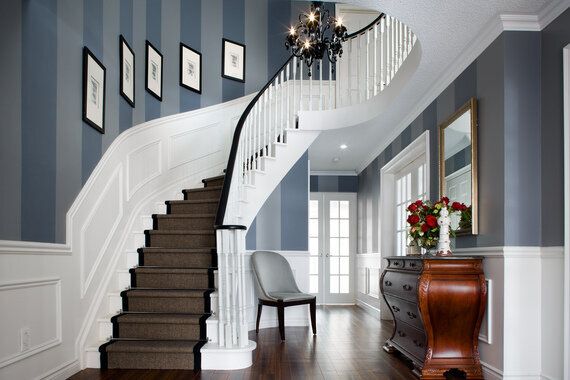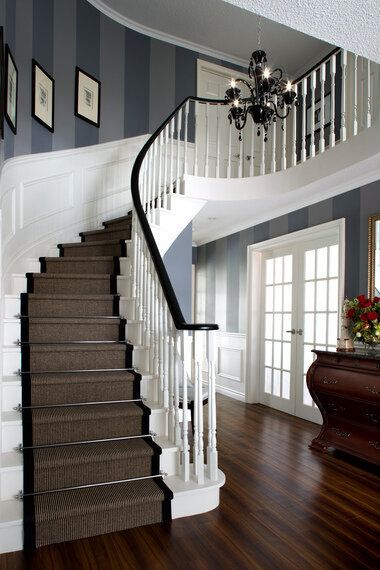Want the down low on faux? Colin and Justin's 101 Guide To Faking It reveals everything you need to know. Hey presto: a striking space with 'timber' floors and 'designer wallpaper' on a strict budget...
As far as C&J decorative issues are concerned, sometimes, just sometimes, things aren't quite what they seem. Indeed now and then, at our behest, a spot of carefully planned artifice, a little caprice and just a touch of illusion are the component parts that bring our designer schemes alive.
Some refer to this schematic flexibility as 'faking it', a term with which we're entirely comfortable. Others acknowledge our (less than dark) art as a means by which to give clients significantly more than their budgets might otherwise achieve.
In the past, we've faked it in many ways. We've attached inexpensive beading a few cm's below ceiling cornice, then painted everything white to give the impression that plasterwork is deeper than it actually is. We've played similar tricks, too, with timber strips positioned above skirting boards: when painted -- along with the original skirting and the area between -- the illusion of stouter detail immediately occurs.
Always remember how schematically 'potent' paint can be. Aside from a million-and-one trompe l'oeil tricks (such as, yawn, marbling, sponging and rag rolling), paint can be used to change spatial perception. A long hall, for example, will appear shorter if the far wall is coloured in a shade that's darker than those it connects.
Similarly, a wide room can be narrowed by painting side walls in a slightly more dramatic version of the same colour. Even tall rooms can be tamed by painting their ceilings a few shades darker than walls.
Design aside, clever tricks can also be played as far as corrective issues are concerned. Bumps in walls, for example, will appear minimized if you use matte as opposed to shinier paint. Smooth walls in small rooms can be painted in a soft sheen finish to help bounce light, thereby promoting (at least the feeling of) better proportions. The art of illusion? It's all part of the service that we, and our design team, offer.
Anyway, let's get down to today's 'before and after'. Oh yes: the heinous hallway depicted in our before shot -- a space so boring our eyes watered as we visited for the first time. Pinky beige, with all the allure of a cadaver, the woeful passage needed to be raised from the dead.
Mathematics at the forefront of our minds, we settled in our style lab' and twisted the vintage balls on our antique abacus until the project's economic conversion made sense. Without doubt we'd have to make better of the tiled floor, and the shaggy carpet would have to go.
There'd be paint to buy, carpet to specify, furniture to locate and homeowners to entertain - we can only imagine it's stressful having the tartan army set loose in one's home...
Keen to effect a massive transformation for our clients (for whom we were simultaneously reworking several rooms), we were extra creative with budget to ensure our sporrans didn't go into meltdown.
Let's start with the floor. Our solution? Amtico -- a plank-form wood-effect flooring finish. Composed with a low profile (approximately 2 millimetres), its application avoided the need for door removal and related prep work, factors which would have negatively impacted on our budget.
Next up - the staircase. A less than holy trinity of institution beige, dated spindles and thick carpet made it reek of the 1980s. First task was to tear away the grizzly carpet, an action that revealed lumber treads and risers. After the horizontal and vertical areas had been thoroughly sanded, we decreed they be painted white, and the results speak for themselves.
This done, the spindles were lavished white and the banister varnished deep, inky black. Adding extra flair to the staircase was a simple task: a sisal stair runner, edged in black, provided immediate 'pop'. Finished with big box store metal stair rods (we call this type of addition 'decorative jewelry') the whole affair came to life.
Now let's get back to fakery, at its finest. D'you like our wallpaper? Well, look again because all is not what it seems. During a previous assignment in London, we used banded paper by Graham and Brown to achieve similar esthetics. However -- and it's a big however -- the London hallway was significantly smaller. During today's project, we also decorated the huge upstairs landing and, had we used wallpaper, we'd have needed 18 rolls in total. At $85 a pop for G&B's Bold Stripe Black and Charcoal, $1,530 would have been immediately swiped from our overall budget. Ouch.
Reeling from the maths, we came up with a simple alternative. Paint. Three coats of pale grey by Benjamin Moore dispatched the fleshy tone and, when completely dry, the magic happened. We marked out bands on the wall and set to work. Tip - opt for low adhesion tape and run a penny along the edges to release tiny air bubbles. This wee job will reduce paint bleed and tempt eminently sharper results.
We opted for a significantly darker grey for the secondary tone and, using a foam roller, applied two even coats to achieve a perfect finish. Tip: Remove the tape before paint dries: this avoids the formation of a microscopic 'shell' that can subsequently crack as tape is pulled away.
In summation, we'd suggest that 'faking it' (in decorative terms, certainly) isn't about pulling the wool over anyone's eyes - it's about achieving results that suggest economics were way more indulgent than they actually were. In our world, whenever a spot of visual trickery is required, it's never about rushing - for us, every step is about precise, careful planning. Which means that, even if we were faking it, you would never, ever know.
Signed Colin and Justin, age 28 and 29.
The hallway before:

After: the stripes and panels create an elegant regency feel:

Using a stair runner carpet rather than full coverage helps define the shape of the sweeping staircase:
